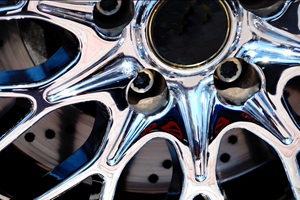Selecting a Touch-Up Gun for an Automatic Finishing System
Liquid coating expert Steve Romer recommends first looking at how the automatic system is being used.
Q: What is the best way to select a touch-up gun for an automatic liquid finishing system?
A: Over the years, I have been asked this question many times. The answer is not as clear-cut as one might think. The biggest consideration should be how the current automatic system is being used.
For example, say you have an aluminum extrusion finishing system with rotatory bell atomizers. If you run the voltage very high, there will be light areas in any Faraday Cage that are present. However, if you were to turn the voltage down a little, those Faraday Cage areas might be covered. Therefore, combining proper bell triggering and flow control, the overall transfer rates would remain high and the touch-up requirements would be dramatically reduced at the same time. Extrusions have a lot of edges and recesses, so dialing in the bell system will minimize touch-up requirements.
I recently visited a plant that was running bell atomizers at a very high voltage, and all the reverse Faraday Cage areas were getting too much paint but the recesses were getting very poor coverage. This shop was using electrostatic hand guns for the massive touch-up requirements. In fact, the touch up was at least 30 percent of the applied coating.
By tuning the automatic bell application system to reduce the electrostatic voltage and increasing the shaping air, the recesses were almost covered and the exposed edges received the correct film builds. The required touch up was limited to deep in the recess Faraday Cage areas. In this case, a very lightweight, non-electrostatic manual gun would work the best.
As explained in this example, the first step in selecting a touch-up gun is to really look at the automatic system and make sure its settings are appropriately tuned in for the parts being finished. Many times, different parts require different settings, so a recipe-based system that changes the various fluid and application settings as appropriate for the parts being finished will allow for a much better overall finishing system and dramatically reduced touch-up gun requirements.
I often use the term application transfer efficiency (ATE) when discussing finishing systems. A system’s transfer efficiency (TE) is often talked about, but ATE combines TE with the required film builds. If the requirement is 1 mil, then any film build over 1 mil is waste. So, even if the application produced 100 percent TE, but the film build was 1.5 mils, the ATE would be 50 percent. This especially applies to automatic paint systems. Last year, we tuned a paint system to bring film builds down to the actual required levels. This not only produced paint savings of 17 percent, but on top of that, no rework was required, so the ATE dramatically improved as well.
So tuning automatic application systems (and really even manual systems) to provide uniform film builds allows us to select the right touch-up gun for the end user. I recently visited another plant and confirmed that the heavy electrostatic gun currently being used was right for how they were running their automatic system, but if we tuned the existing system (or maybe upgraded to a bell application system to provide better film-build control), they could change to a more lightweight air spray hand gun and cover the very slight Faraday Cage areas and save a lot of paint. In this case, the overall savings will be around 30 percent, and with $9 million of coatings being used at this facility, a 30 percent overall paint savings could generate a savings of about $3 million.
It is not easy to select the right touch-up tool. The real trick is to optimize the automatic system for the required film builds and coverage, then select the right touch-up tool for the remaining areas. It’s important to remember that touch-up is just a part of a finishing system and find a solution that addresses the entire operation.
Related Content
An Overview of Electroless Nickel Plating
By definition, electroless plating is metal deposition by a controlled chemical reaction.
Read MoreAlkaline Cleaning Guide
Gregg Sanko, Senior Chemist, Oakite Products, Inc. provides an overview of the alkaline cleaning process.
Read MoreHow to Address Declining Powder Coating Coverage Over Time
Fine particles from reclaim could be to blame for powder coating problems that emerge over time. Avoid problems by keeping hooks clean, maintaining guns and using reclaim powder quickly to avoid accumulation of fines.
Read MoreA Chromium Plating Overview
An overview of decorative and hard chromium electroplating processes.
Read MoreRead Next
A ‘Clean’ Agenda Offers Unique Presentations in Chicago
The 2024 Parts Cleaning Conference, co-located with the International Manufacturing Technology Show, includes presentations by several speakers who are new to the conference and topics that have not been covered in past editions of this event.
Read MoreEducation Bringing Cleaning to Machining
Debuting new speakers and cleaning technology content during this half-day workshop co-located with IMTS 2024.
Read MoreEpisode 45: An Interview with Chandler Mancuso, MacDermid Envio Solutions
Chandler Mancuso, technical director with MacDermid Envio discusses updating your wastewater treatment system and implementing materials recycling solutions to increase efficiencies, control costs and reduce environmental impact.
Read More












.jpg;maxWidth=300;quality=90)











